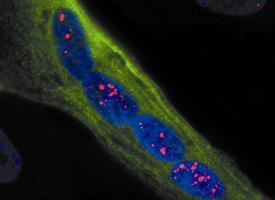Neurogenetic Disorders

Deposits of toxic RNA (red) are seen
here inside muscle cell nuclei (blue)
from an individual with myotonic dystrophy.
Myotonia is a state of hyperexcitability in muscle fibers in which a voluntary contraction or electromechanical stimulation can provoke trains of repetitive action potentials. This causes delay in relaxation after a muscle contraction. The repetitive action potentials are generated by the muscle fibers, independent of any input from the motor neuron. Myotonia is caused by dysfunction of ion channels in the muscle membrane.
There are several ways in which myotonia can be observed. Action myotonia refers to muscle stiffness and delayed relaxation that can be seen following a voluntary contraction. For example, action myotonia often affects movements of the fingers and can interfere with many ordinary tasks, such as, writing or opening a door. Electromyographic myotonia refers to the repetitive discharges that are triggered when an extracellular recording electrode is inserted into a muscle. In mice this is done with a tiny (30 gauge) needle electrode under general anesthesia. In humans it is done without anesthetic. When electromyography (EMG) is performed on a normal muscle, insertion of the electrode triggers a brief (less than 20 msec) flurry of discharges. When EMG is performed on a muscle with myotonia, insertion of the electrode triggers an extended series of repetitive discharges lasting up to 30 seconds.
Myotonia is a cardinal feature in 4 human diseases:
- Myotonic dystrophy type 1 (autosomal dominant, caused by an expanded CTG repeat in the DMPK gene on chromosome 19)
- Myotonic dystrophy type 2 (autosomal dominant, caused by an expanded CCTG repeat in the ZNF9 gene on chromosome 3)
- Generalized myotonia congenita (autosomal recessive or dominant, caused by mutations in CLCN1, the gene encoding the muscle-specific chloride channel, ClC-1)
- Potassium-aggravated myotonia (autosomal dominant, caused by mutations in SCN4A, the gene encoding the alpha subunit of the muscle-specific sodium channel)
Myotonic dystrophy is the most common disease that causes myotonia. Recent studies in our laboratory indicate that the myotonia in myotonic dystrophy is caused, at least in part, by reduced expression of the ClC-1 chloride channel (Mankodi, et al, Molecular Cell, July 2002).
Several strains of mice with myotonia have been isolated. All spontaneous mutations that cause myotonia in mice are allelic. These strains are called "adr", for arrested development of righting response (i.e., the mice are slow to regain their upright posture after being tipped on their side). Adr strains have mutations in the murine Clcn1 gene, similar to the mutations that cause human generalized myotonia congenita.